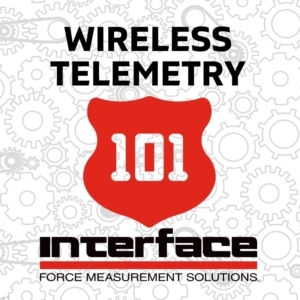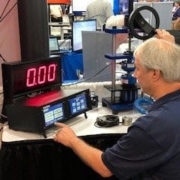Wireless Telemetry Systems 101
 A wireless telemetry system enables the remote measurement and transmission of data from one location to another without the need for physical wired connections. As technology advances, wireless telemetry systems are becoming increasingly sophisticated, reliable, and secure, enabling them to be applied in various industries and use cases for test and measurement applications.
A wireless telemetry system enables the remote measurement and transmission of data from one location to another without the need for physical wired connections. As technology advances, wireless telemetry systems are becoming increasingly sophisticated, reliable, and secure, enabling them to be applied in various industries and use cases for test and measurement applications.
Interface offers a wide range of wireless telemetry products. Components in wireless telemetry systems typically include sensors, transducers, instrumentation, communication modules, transmitters, displays, and printers.
The sensors measure tension, compression, weight, torque, or any other measurable quantity. Interface utilizes proprietary strain gage sensor technologies. Transducers convert analog signals from sensors into digital data that can be processed and transmitted to instrumentation.
Load cells are commonly used with wireless telemetry systems to measure and transmit data about the force or weight applied to an object. The load cell converts the force exerted on it into an electrical signal, which can then be wirelessly transmitted to a remote monitoring system.
The most popular Interface wireless load cells are our WTS 1200 Standard Precision LowProfile® Wireless Load Cell, WTSTL Wireless Tension Link Load Cell, WTSLP Wireless Stainless Steel Load Pin and WTSSHK-D Wireless Crosby™ Load Shackle. Interface works with our customers to develop engineered-to-order wireless solutions by request.
The analog output from the load cell may require signal conditioning to ensure accuracy and compatibility with the wireless telemetry system. Signal conditioning can also be required for amplification, filtering, and analog-to-digital conversion to convert the analog signal into a digital format.
Wireless communications modules are responsible for transmitting the data over wireless channels. It can use various communication technologies like Wi-Fi and Bluetooth, depending on the application’s requirements. The transmitter is responsible for wirelessly communicating the load data to the receiving end of the telemetry system.
There are various options for data collection. Data acquisition instrumentation is preferred in force measurement applications to collect vast amounts of data from sensors and transducers and prepare it for transmission.
At the receiving end of the telemetry system, another wireless communication module receives the data from the load cell’s transmitter. Once the data is processed, it can be analyzed, logged, and displayed on a user interface, such as a computer dashboard or a mobile app. This allows operators, engineers, or users to monitor the load values in real-time and make informed decisions based on the data
Interface Wireless Telemetry System (WTS) Solutions
The Interface Wireless Telemetry System (WTS) offers flexibility by eliminating physical connections, making deploying sensors in remote or challenging environments easier. Wireless telemetry systems offer more flexibility in sensor placement and system configuration.
The absence of physical wires allows for easier repositioning or adding new sensors without significant infrastructure changes. This setup is particularly useful in scenarios where it is challenging or impractical to use wired connections, such as in large-scale industrial applications or when monitoring moving or rotating machinery.

Wireless Telemetry System Components
Wireless Transducers
- WTS 1200 Standard Precision LowProfile® Wireless Load Cell
- WTSLP Wireless Stainless Steel Load Pin
- WTSSHK-D Wireless Crosby™ Load Shackle
- WTSSHK-B-HL Wireless Bow Load Shackle
- WTSSHK-B-JR Wireless Crosby™ Bow Load Shackle
- WTSATL-JR Aluminum Compact Wireless Tension Link
- WTSATL Lightweight Aluminum Wireless Tension Link
Wireless Transmitters
- WTS-AM-1E Wireless Strain Bridge Transmitter Module
- WTS-AM-3 Wireless 4-20 mA Transmitter Module
- WTS-WSS Wireless Wind Speed Transmitter Module
- WTS-BS-1-HS Wireless Handheld Display for Single Transmitters
Wireless Receivers
- WTS-BS-4 Wireless Base Station with USB Interface in Industrial Enclosure
- WTS-BS-6 Wireless Telemetry Dongle Base Station
- WTS-BS-2 Wireless Base Station with Industrial Interfaces
- WTS-BS-3E Wireless Base Station with USB Interface
Wireless Output Modules
- WTS-BS-5 Wireless Analog Output Receiver Module
- WTS-GW1 Wireless Gateway with Modbus and ASCII Serial Output
- WTS-PR1 Wireless Telemetry Printer
Wireless Displays and Instrumentation
- WTS-LD1 Wireless Large LED Display
- 9812-WTS Wireless Panel Mount Display for Single Transmitters – NEW!
This is a list of what types of products are available. The Interface WTS offering continues to grow with added products to the line. Check out the Wireless Modular System Overview for more system details.
Wireless Telemetry System Benefits
The Interface WTS is a wireless telemetry system that transmits high-quality data to single and multiple devices. It offers a wide variety of benefits, including:
- High accuracy: The WTS offers measurement accuracy of ±0.02% of full scale, ensuring you get accurate readings from your sensors.
- High speed: A high-speed system can transmit data up to 1000 Hz.
- High resolution: The WTS has a resolution of 10,000 counts, which means that you can measure even slight changes in force.
- Multiple configuration options: The WTS can be configured to meet a wide variety of needs. You can choose from a variety of transmitters, output modules, receivers, antennas, and displays.
- Easy to use: It is a modular system that can be easily expanded to meet the needs of your application. It is supported by our powerful WTS Toolkit configuration software, making it easy to set up and use.
- IP-rated enclosures: The WTS transmitters and receivers are available in two different-sized enclosures that are rated to IP67, making them dustproof and waterproof.
A major benefit of wireless telemetry systems is the ability to adapt and expand by adding additional sensors or devices without the constraints of wires and cables. They are easy to integrate, and installation is fast for immediate benefits.
Wireless telemetry integrates with the Internet of Things (IoT) and cloud-based platforms, enabling centralized data storage, analysis, and easy access from multiple devices.
Read: Interface Wireless Telemetry System Review
Applications Using Interface Wireless Telemetry System Solutions
Aerospace: Wireless options are preferred for large projects that require careful movement and testing of aircraft, components, and systems. Providing flexibility in real-time data without the cable is a huge benefit. See these WTS solutions for Aircraft Engine Hoist and Airplane Jacking System
Industrial Automation: Load cells with wireless telemetry are commonly used in industrial environments for weighing large objects, such as in material handling, manufacturing, and logistics. Check out IoT Lifting Heavy Objects.
Medical and Healthcare: Wireless medical telemetry systems, such as wearable health devices, are used for patient monitoring. In medical settings, wireless load cells are used in patient lifts and hospital beds to monitor patient weight and movement. Learn more in our Patient Hoyer Lift application.
Agriculture: The agriculture industry uses WTS to monitor crop management programs and measure the weight of produce, animal feed, or livestock. Check out this use case: WTS Equine Bridle Tension System App Note.
Energy: The energy industry utilizes wireless load cells and telemetry products to remotely monitor oil wells, pipelines, and storage facilities. Check out Tank Weighing and Center of Gravity
Infrastructure: Civil engineers use WTS to assess the health and integrity of structures like bridges and dams. Monitoring loads on bridges and cranes to ensure safety and structural integrity. Check out Road Bridge Lift Monitoring.
Manufacturing: There are many examples of manufacturing WTS use cases. Wireless load cells are being used to monitor the weight of products as they move through the production line. This information can be used to ensure that products meet quality standards and identify any potential problems early on by fully utilizing the wireless telemetry capabilities.
Construction: In the construction industry, wireless load cells and telemetry systems monitor the load on beams and columns during construction to ensure that structures are safe and stable and to detect any potential problems before they cause an accident. Check out Jib Crane Tension Monitoring.
Transportation: In the transportation industry, wireless load cells are being used to monitor cargo weight on trucks and trains to ensure that loads are not overloaded and to comply with regulations. Read IoT Waste Management Container Weighing.
Automotive: The industry utilizes several machines and systems to test components used in the making of automobiles. Read how WTS is used in this brake testing application: WTS Brake Pedal Force Testing.
Entertainment: Protecting the artists, equipment, and attendees is top of mind for all venues. Wireless systems monitor environmental conditions, rigging, display mounts, and more. Read Multi-Stage Load Monitoring.
Integrating load cells with wireless telemetry systems provides a convenient and efficient way to monitor force or weight data remotely, allowing for real-time data analysis and enhancing the automation and safety of various processes.
If you are looking for a reliable and accurate wireless telemetry system, the Interface WTS is a great option. It is a powerful and versatile system that can be used in various applications. and industry use cases.








